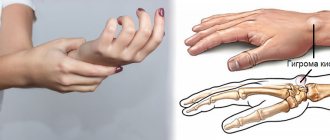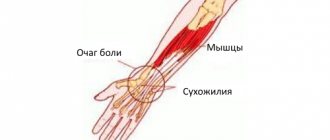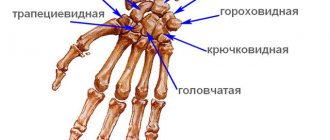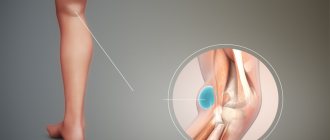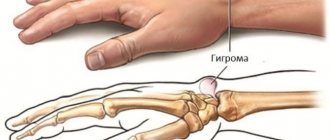Hygroma of the wrist joint
, cyst, ganglion, synovial hernia are the names of a benign tumor that is localized above the wrist joint. Women get sick more often. In some cases, the formation resolves on its own, without treatment.
Hygroma of the wrist is a round capsule with dense walls, filled with a viscous liquid. Can be located on the outside or on the inside. Transformation into a malignant tumor does not occur. Treatment aims to eliminate the external defect.
Diagnostics
To make an accurate diagnosis, you should consult an orthopedic surgeon. Determining the causes of the disease and treatment methods involves conducting an examination: the doctor must determine the location of the tumor and its size. Of the laboratory tests, only a biopsy will be indicative.
Diagnosis is carried out using:
- MRI or ;
- Ultrasound;
- X-rays;
- If necessary, a puncture of the hygroma is taken.
Synovitis and synovial cysts
Synovitis is an inflammatory disease that affects joint tissue. Its insidiousness lies in the fact that at first the pathology does not reveal itself. Late diagnosis of the disease can lead to serious complications - fluid accumulates in the membrane, the joint increases in size and synovial cysts form. Joints are exposed to physical stress every day, so the formation of inflammatory processes is not uncommon. Synovitis often manifests itself in a chronic form and is dangerous because it provokes pathological processes throughout the body.
Kinds
Synovitis develops in a joint - elbow, ankle, knee or wrist. Usually the disease affects one location, less often - several joints. Several types of synovitis are classified depending on the form and duration of the process:
- Acute - the disease has pronounced symptoms and responds well to treatment. With timely, high-quality medical care, acute synovitis goes away without consequences for the joint.
- Chronic - in this case, synovitis is masked for a long time and does not manifest itself in the form of characteristic symptoms. The disease is dangerous because it leads to the formation of synovial cysts, frequent relapses and remissions, and also changes a person’s usual lifestyle.
Chronic synovitis and the formation of cysts against its background develop against the background of incorrect treatment or the absence of an acute form. Contacting our clinic will allow patients to promptly diagnose the inflammatory disease and prevent the occurrence of associated pathological processes.
Depending on the provoking factor, the following forms of synovitis are distinguished:
- Serous - liquid of a characteristic transparent yellowish color accumulates in the joint;
- Hemorrhagic - the contents contain blood impurities;
- Fibrinous - fibrinogens are found in the fluid;
- Purulent - a dangerous form of synovitis, characterized by the appearance of pathogenic flora in the joint;
- Mixed - involves a combination of several types of liquid.
Causes
The most common cause of the development of synovitis and synovial cysts is mechanical damage as a result of trauma. Sometimes a small blow is enough for the pathological process to start. As a result, microcracks form in the fiber of the articular membrane, which, with regular loads, provoke the accumulation of fluid.
The following associated pathological causes are identified:
- arthritis;
- arthrosis
- bursitis;
- Baker's hernia.
There are a number of indirect reasons that can provoke the development of synovitis and synovial cysts:
- excess body weight;
- autoimmune diseases;
- allergies in the acute stage;
- Metabolic dysfunction.
Synovitis often affects the joints of older people. Natural aging processes in the body trigger degenerative mechanisms and provoke the development of inflammatory diseases.
Symptoms and signs
Acute synovitis is characterized by pronounced symptoms. Typically the patient exhibits the following symptoms:
- pain in the affected area;
- swelling;
- fever;
- decreased joint mobility and impaired motor function.
Which doctor treats
An orthopedist treats synovitis.
Diagnostic methods
The purpose of the initial examination is to check the condition of the joint visually. In order to understand how much fluid has accumulated, as well as to determine the presence of synovial cysts, the patient is prescribed one of the instrumental research methods - MRI or ultrasound.
The causes of the inflammatory process are determined using the following examinations:
- blood test for bacteria;
- general blood analysis;
- puncture.
Treatment methods
The main goal of treating synovitis is to block the source of inflammation. The patient is first prescribed complete rest, which can be achieved by applying a splint or plaster cast to the damaged joint. After studying the tests and examination results, the doctor will decide on further treatment, including a set of measures:
- non-steroidal anti-inflammatory drugs;
- antibiotics;
- corticosteroids;
- getting rid of accumulated fluid;
- physiotherapy;
- massage.
If conservative methods are powerless, the patient is prescribed a surgical operation, which involves partial or complete removal of the inflamed joint membrane.
results
The final result depends on several factors - the speed of seeking medical help, the presence of concomitant pathologies and the causes of inflammation. If measures were taken on time, synovitis goes away without a trace and does not return again.
Rehabilitation and lifestyle restoration
It all depends on the form and severity of the disease. Many patients are prescribed a complex of exercise therapy as a comprehensive measure, which allows them to speed up the recovery process and improve metabolic processes within inflamed tissues. Proper treatment and timely seeking medical help guarantee the patient a complete recovery and return to their normal lifestyle.
Lifestyle with synovitis
Experts recommend the following measures for those who have been given a similar diagnosis:
- wearing comfortable shoes;
- refusal of intense physical activity;
- physical education classes;
- rejection of bad habits;
- regular preventive examinations with a doctor.
Follow your doctor's recommendations and live a full life!
Track.
article Prev. article
Types of disease
The ganglion of the wrist joint of the hand can be classified:
- Mucosal hygroma - appears as a result of deforming arthrosis, as a result of compression, the growth of connective tissue is a protective reaction of the body;
- Post-traumatic hygroma of the left or right wrist - occurs as a result of damage to the joint;
- Tendon hygroma - develops under the influence of pathological changes in the tendon sheath, causes pain, and interferes with normal movement of the wrist.
Reasons why a neoplasm occurs
The formation of an articular cyst on a finger or wrist occurs for the following reasons:
- Performed movements of a repetitive type;
- Accidental injury to the limbs and their mechanical damage;
- Heredity factor.
Athletes who place stress on their hands are at greatest risk of injury. Growths appear in people whose field of activity is related to sewing and music. Any person who sits at a laptop or computer for a long time is also susceptible to it.
Treatment of hygroma / ganglion of the wrist joint
When the disease worsens and discomfort occurs, anti-inflammatory drugs are used.
If the formation increases, if there are restrictions in movement, the hand becomes numb and hurts, you need to contact a surgeon or traumatologist. Surgery may be needed.
Surgical intervention is required if the formation has a cellular structure or its size increases.
During the operation, the hygroma is removed along with the capsule.
The safest and least traumatic removal of hygroma is using a laser. In addition to laser removal, endoscopic excision of hygroma of the wrist joint has proven itself well.
It is important to remember that after removal by any method, relapse may occur.
The operation to remove hygroma is simple, performed under local anesthesia:
- A special needle is inserted into the cyst cavity;
- Liquid contents are removed;
- The cavity is washed with an antiseptic, and an antibiotic can be used.
After removing the hygroma, a bandage is applied for several weeks. Premature removal of the bandage can provoke re-formation of the cyst.
Kinds
There are wrist cysts, which are classified according to the classification into single-chamber and multi-chamber. The appearance of hygroma (mucosal tumor) depends on the location of formation:
- A wrist cyst is located on the outer part of the palm of the hand. It interferes with any movement, so it must undergo serious treatment.
- A cyst of the synovial type. Located on either side of the finger. Its localization is near the phalanx, in the nail part. The reason for its appearance is the psychosomatics of joint pathology.
- A growth formed on the palm. There is no big size. Not capable of causing global discomfort.
Tumors are not dangerous, but they reduce the level of performance. May also interfere with proper hand control.
Epidermal cyst - causes
The mechanism of development of the pathological process in which an epidermal sebaceous cyst is the blockage of the duct of the sebaceous gland, while its secretion accumulates. Over time, the volume of accumulated sebum increases, and horny masses, which are exfoliated cells of the epidermis, are added. There are several reasons for the development of such education:
- A metabolic disorder that leads to a thicker consistency of sebum with blockage of the gland ducts.
- Inflammatory processes of the skin (including acne or acne, as well as inflammation of the hair follicles) lead to swelling, which reduces the diameter of the excretory ducts of the glands.
- Traumatization of the skin, followed by scarring, while the connective tissue compresses the ducts of the sebaceous glands.
- Insufficient hygiene leads to blockage of the sebaceous glands with horny skin scales.
- Excessive enthusiasm for various cosmetic products or their improper use.
- Hormonal imbalance, in which the regulation of the process of sebum formation, as well as its release to the surface, is disrupted.
- Genetic predisposition.
Simultaneous exposure to several causes significantly increases the risk of developing such a voluminous skin formation.
Treatment at home
Folk remedies are an additional method of therapy to the main treatment prescribed by the doctor.
Infusions that can slow down the growth of cysts on the arm:
- An alcohol solution can be made from anti-inflammatory plants: sage, chamomile, string and others. Both infusions and decoctions are suitable for therapy. The infusions should be applied to the area that hurts and secured with a bandage for a long time, up to two or three hours in a row. Their use has a positive effect if done twice every 24 hours or more. Decoctions should be drunk with caution.
- Inflammatory signs can be reduced when using tinctures from the coniferous family. You need to soak gauze in the solution and apply it to the swollen limb. The important point is that the bandage should not fit too tightly. The interaction time is until the material dries completely.
- Cabbage leaf for purulence and reduction of inflammatory signs. A cabbage leaf is attached to the affected area and tied with a cloth.
- Red clay. Mix it with water until it becomes a paste, spread it on a brush and wait until it dries completely, then wash it off.
The methods do not bring much benefit, but they somewhat slow down the growth of the growth, reducing inflammation. Folk remedies alone cannot defeat a cystic formation; you will have to visit a surgeon.
Treatment with salt baths
A salt bath with sea salt is another way to treat cystic tumors at home. Since ancient times, salt has proven itself due to its healing properties that have a positive effect on the body as a whole.
A bath with sea salt relieves pain and restores joint mobility. Ingredient ratio: a spoonful of salt for every liter of water. Carrying out regular bath procedures leads to good results.
In addition to sea salt, you can use table salt, heated over a fire and poured into a small bag. Frequent application will give good results.
Treatment of wrist cyst
To treat a cystic growth on the wrist, golden mustache juice is used, which is rubbed on the painful area, then a cabbage leaf is applied. Beef bile compresses are also effective; they need to be changed every three hours.
Treatment of hygroma on the finger
The best folk method for resolving a cyst on a finger is paraffin. Heat can be therapeutic. The substance must be melted in a steam bath, applied to the painful area with a spatula, covered with a plastic bag and wrapped in a towel to conserve heat.
It is recommended to use alcohol tinctures, which transmit “dry” heat into the tissue. Valerian, calendula, celandine and other tonic herbs are suitable for these procedures. A piece of bandage is soaked in the solution and applied as a compress, wrapped in a plastic bag and a warm towel. The “exposure” session lasts about half an hour.
An interesting method of treating a cyst on a finger using copper. According to reviews, it is effective and safe. To do this, weld a ring of copper wire, put it on and do not remove it for three months. There will be no trace left of the small formation.
Preventive measures
There are special preventative methods to prevent cystic proliferation:
- Protect yourself from accidental injuries, avoid bruises from falling and mechanical trauma, especially after a fracture.
- The use of moderate physical activity is a serious indication. You should not overdo it in sports training or other activities, so as not to strain the arm joint.
- Take a break from monotonous, monotonous work and don’t miss a moment to stretch your limbs.
- If you suspect an injury, especially in a child, you should immediately visit a doctor.
- Do not get a tattoo on this area.
A formation on the hand or arm joint is not fatal, but causes pain and discomfort. It is excised through surgery because medications cannot provide adequate treatment and it slows down growth. Surgical intervention is a complex process that requires experience and dexterity of the hands of a surgeon.
